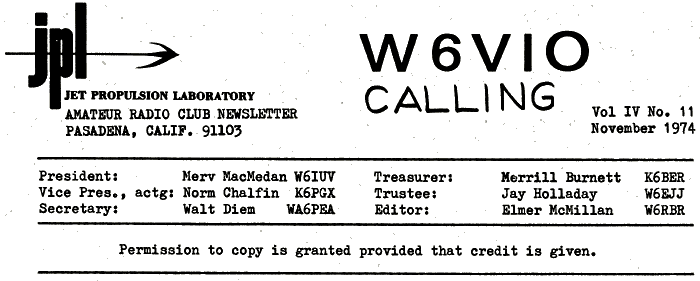

CLUB MEETINGS:
Regular Meetings are held on the second Wednesday of each month at 12 noon, in Room 238-543. They are open to all.
Board of Directors meet the fourth Wednesday of each month at 12 noon in 198-111. All club members are invited.
ARRL ELECTION RESULTS, SOUTHWESTERN DIVISION
Southwestern Division Director John Griggs, W6KW was returned to office unopposed. In the Vice Director race, ballots were counted on November 20 with the following results, as reported by W1AW:
Jay Holladay, W6EJJ 1640
Arnold Dahlman, W6UEI 908
C. R. MacKay, K60PS 802The new two-year terms of office begin on January 1, 1975. Congratulations, Jay!
AMSAT-OSCAR 7 LAUNCH SUCCESSFUL
After several postponements, the AMSAT-OSCAR 7 spacecraft was successfully launched on November 15, 1974. Liftoff from the Western Test Range (Vandenberg AFB) occurred at 1711 GMT and the Delta 104 launch vehicle performed nearly flawlessly in placing three payloads into their intended orbits. Primary payload was the ITOS-G weather satellite; the other secondary payload was the INTASAT Spanish scientific satellite.
Early telemetry data indicated that AMSAT-OSCAR 7 was performing properly, and pass predictions based on preflight nominal orbit data agreed quite closely with actual time of signal acquisitions.
After several orbits had been tracked, AMSAT released the following reference orbit:Date Rev No. S-N Equator crossing
18 Nov. 30 0150 hrs 46 sec GMT, 77.650 W.LongitudeThis orbit may be used to make predictions based on the following constants:
Period: 114.9905 minutes
Longitudinal increment: 28.748 degrees west per orbitUsing a pocket calculator and keeping track of 3 or 4 decimal places should result in usable predicts for the next two or three weeks.
W6EJJ has had about 10 contacts through the two-to-ten meter translator on OSCAR 7 and he has observed that downlink signals are good and strong in the 10-meter passband, but the 2-meter receiver does not appear to be as sensitive as the one on OSCAR 6. The 10-meter telemetry beacon on 29-502 MHz has much stronger signals than the OSCAR 6 beacon, so anyone should be able to copy the OSCAR 7 beacon and reduce telemetry data if they wish.
The 70-cm (432 MHz) to 2 meter translator appears to be quite sensitive ... in fact, many early users have been overloading the uplink receiver. AMSAT now requests that users of this translator limit their uplink power to 80 watts effective radiated power.
Further information on OSCAR 7, such as uplink and downlink frequencies, may be found in the October issue of W6VIO Calling. We aim to keep you informed!
GRAPHIC AID FOR ORBIT CALCULATIONS AVAILABLE
An orbit calculator specialized for the Los Angeles area, has been developed by K6KSY and many were sold at the JPLARC AMSAT-OSCAR presentations at the recent Southwest Division Convention in San Diego. For the benefit of club members who may wish to buy one, Jay Holladay, W6EJJ, has a small stock. They are $1 each, including an instruction booklet. You may reach Jay at Ext. 4443.
PJ9JR
JPLARC Member Chas. Weir, W6UM, joined six other members of the Potomac Valley Radio Club for a DX-pedition to Curacao. They operated under the call PJ9JR in the CQ World Wide Phone DX Contest, October 26 and 27. Six positions were in use, one on each band from 10 through 160 meters. With conditions far from outstanding, they made over 10,000 contacts during the contest for a total score of over 19,000,000 points ... believed to be the world's record! But Chas. tells us that the highlight of the whole trip was meeting the local PJ hams at a big dinner before the contest began and enjoying their superb hospitality!
NASH RETURNS
We were all extremely happy to see Nash Williams, W6HCD, return to his job at JPL on November 189 after six weeks of suspended animation while recovering from a Heart attack. He looks well, works well, and seems in "vy gd cndx - rebuilt."
QRL? POSITION WANTED
RF microwave engineer (hardware oriented) would like to remain with the lab. Has 17 years experience designing and developing cavity devices, vacuum tube, solid state and passive transmitters and instruments. Norm Rhinehart, W6ACZ. Phone Lab, 6697; home, 798-1931.
INCOGNITO
Former JPLARC member Bill Gillmore, WB6JWT, now holds the call K6NQ (per latest call book.)
HAM RADIO LICENSES-IN USSR
In a recent question and answer program heard on Radio Moscow, a listener asked about ham radio licenses in the USSR. The reply indicated that there are three grades of licenses. Grade three is for beginners, and requires a very simple code and theory test. Maximum power permitted is ten watts. The second grade permits forty watts, while first grade allows 200 watts. Each step requires demonstrating more proficient keying and proficiency in DX competitions, as well as technical expertise. Moreover, all applicants must demonstrate an elementary knowledge of the English language to permit their effective competition in the contests, since these are generally conducted in English. Amateur radio in the USSR is considered a "sport" rather than a "hobby" and as such is supported much like other types of sporting activities.
FABRICATION AND TEST LAB PROPOSED
Bill Paxton, K6ZHO, a retired Lockheed engineer, is working toward establishing an electronics laboratory at Glendale Community College which would offer sophisticated electronics test equipment, and capabilities for sheet metal forming, printed circuit photography, etc., which none of us could afford individually. If you would be interested in the creation of such a facility, please send your affirmative comments with a SASE for further information to Bill Paxton, K6ZHO, 720 Glenandale Terrace, Glendale, Calif. 91206.
HAPPY
THANKSGIVING
T0 ALL
Go back to the W6VIO Calling Index.